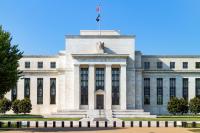
Marc-Antoine Collard, Chief Economist – Director of macroeconomic research
A trade conflict with the US’s closest economic partners might begin soon, and all indications are that these actions are a start to a widening trade war. The complete ramifications are unknown, yet the cost of uncertainty could be large and increases the risk of stagflation.
Higher inflation, lower growth?
US President Donald Trump announced his intention to impose heavy tariffs on goods imported from Mexico, Canada and China and, as a result/subsequently, all three nations announced their intention to retaliate. Model estimates suggest that the size of a sustained 25 per cent tariff hike is large enough to throw the Mexican and Canadian economies into recession. Yet, although smaller, the impact on the US economy is most likely not trivial.
As US demand shifts from foreign to domestic goods, some sectors will initially benefit from trade barriers. But this is just one side of the story. Nearly half of the goods the US import come from these three countries, and the tariffs announced by Trump, along with retaliatory actions, could both slow economic growth and raise prices.
Regarding inflation, economists have long understood that tariffs burden domestic purchasers of imported goods, in contrast to some frequent and mistaken claims that foreigners bear the direct costs. It remains to be seen how much of the import tax would be absorbed by US importers through lower profit margins, and what proportion ends up being paid by US consumers, but it will disrupt supply chains that have not fully recovered from the past year’s shocks, raising costs for businesses, and ultimately driving up consumer prices. The prospect of higher inflation from the trade war would probably further delay any further Fed easing and possibly boost long-term interest rates, thus hurting the economy.
Tariffs could also lower economic activity through different channels. The US exports more than US$750 billion (1) in goods to Canada, Mexico and China, and slower economic growth in these countries could significantly reduce those exports, especially as they would be forced to retaliate in ways that are designed to maximise economic pain.
Furthermore, US production involves significant imported inputs. For instance, cars move back-and-forth across the border multiple times during assembly, and a trade war would make some North American sectors much less competitive.
Equally serious, the uncertainty caused by the trade policy uncertainty could stall production and investment as businesses can hardly decide on whether to build a plant in Canada, Mexico or the US without having some idea of the tariffs that could be levied upon it. In fact, the 2018-19 trade war highlighted the central role that business sentiment swings play in the transmission of a tariff shock.
For now, the global manufacturing PMI (2) improved somewhat in early 2025 to the neutral 50-threshold (3), as sentiment was in part supported by businesses’ desire to build inventories before the possible installation of higher trade barriers, which temporarily spurred activity. In addition, trade policy did not feature prominently in Trump’s inaugural address, which initially reassured businesses and investors. Yet, confidence will be a key determinant of global macroeconomic outcomes over the coming year, and the manufacturing PMI might get hit significantly after the latest threats from the new US administration.
An uncertain new source of revenue
Investors have been of the view that the most aggressive threats from Trump’s election campaign were just tools to extract deals from trading partners. Yet, most Trump administration officials genuinely think that tariffs could become a new source of revenue, reducing the reliance on income taxes in a context of fragile fiscal outlook.
Indeed, public debt levels are elevated around the world, and the US is no exception. Its debt is at record levels and the long-term trajectory is unsustainable, although a precise tipping point is unknown. The Congressional Budget Office (4) (CBO) predicts gross federal debt will reach more than 135 per cent of GDP by 2035, a level greater than at any point in the US history.
However, these are conservative estimates, as they assume corporate and personal tax cuts of the 2017 Tax Cut and Jobs Act (TCJA) – which are supposed to expire at the end of 2025 – will not be extended. This is an unlikely outcome, given that the Republicans control Congress and the White House. In fact, if all tax provisions were to be extended, the deficit would be deeper, and debt would be expected to climb accordingly. What’s more, the CBO’s baseline projections assume that no US recession occurs in the next ten years, inflation falls back to normal levels and stays there, and thus debt financing costs remain low. Higher-for-longer interest rates are obviously posing a challenge to serviceability.
The irony is that while the tariffs could indeed generate extra federal tax revenue, the increase might be much more muted than hoped, precisely because the tax base, namely imports, will decrease due to the trade war. In fact, with lower exports and imports, the trade deficit might end up not improving much, if at all.
Unintended longer term consequences
Given the relative strength of the US and weakness of many other countries – both cyclically and structurally – the weaponisation of trade promises some gains for the US in the short-term. However, while substantial uncertainty remains around the timing and implementation of future tariffs, the risk of stagflation has increased, especially as the current policy threatens to dismantle a multi-decade free-trade agreement that could disrupt a deeply interconnected network and depress North American business sentiment, heightening the risk of non-linearities not captured in economic models.
What’s more, faced with significant global challenges, the US cannot operate alone, without the active cooperation of partners, and its capacity to dominate the global financial and economic system is directly linked to the sustainability of the network of transatlantic and transpacific alliances. In that regard, Trump seems to have squandered alliances and influence that his predecessors had built before him, as evidenced by his decision to violate the USMCA – a deal that his own administration negotiated – that runs contrary to the rule-based global trading system that the US helped create after the World War II. Overall, he is giving strong incentive for countries to reduce their economic and financial dependence on the US and accelerate the fragmentation of an international economic order that has historically served America well. In the end, this could well undermine its economy, its power and its national security.
(1) Source: Bloomberg, February 2025.
(2) Purchasing Managers' Index, an indicator reflecting the confidence of purchasing managers in a sector of activity. Above 50, it indicates an expansion in activity, below 50, a contraction.
(3) Source: S&P Global, January 2025.
(4) Congressional Budget Office: US federal agency responsible for calculating the effects of the national debt.







